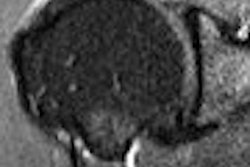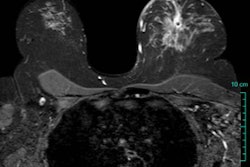Gadolinium-based contrast agents may not be the only culprit in the development of nephrogenic systemic fibrosis (NSF), and a new case report from the University of Texas in Galveston supports that theory. This multispecialty group reviewed a decade's worth of data, taking into consideration contrast-enhanced MR studies as well as a broad range of other risk factors. The findings were released online this week in the American Journal of Roentgenology.
"Our institution has conducted MRI examinations with gadolinium-based contrast agents since the late 1980s.... A retrospective review of our institution's dermatopathology database was conducted to discover all cases of (NSF) diagnosed from 1997 to 2007," wrote Dr. Clark Wiginton and colleagues from the university's departments of radiology, dermatology, and nephrology, as well as the school of medicine (AJR, April 2008, Vol. 190:4, pp. 1-9).
Two different gadolinium-based contrast agents were used in the time period covered in the study: Gadopentetate DTPA (Magnevist, Berlex, Montville, NJ) was used until September 2000, then gadodiamide (Omniscan, GE Healthcare, Chalfont St. Giles, U.K.) from September 2000 to the present.
NSF patient records were reviewed for prior MR exams, as well as details on gadolinium-based contrast agent usage, with multiple doses summed up into a cumulative dose. The data was then plotted against the time from first exposure in renal failure to symptom onset. Charts from an outpatient dialysis clinic were also reviewed and cross-referenced with MRI studies. Finally, skin biopsy results from seven NSF patients were evaluated with scanning electron microscopy energy-dispersive x-ray spectroscopy.
Overall, 138 MR studies were conducted in 83 patients, 72 of whom underwent 127 contrast-enhanced MR studies. Among 18 of the 72 patients, 23 gadopentetate-enhanced studies were done with no cases of NSF. Sixty-three patients had 104 gadodiamide-enhanced studies and two of these patients developed NSF.
In total, the authors found seven cases of NSF diagnosed between 2001 and January 2007. The mean patient age was 47 years, and four of the seven patients were female. All seven received gadodiamide contrast before symptom onset and while in renal insufficiency. None had received gadopentetate. Three patients developed symptoms after a single exposure to gadodiamide at a mean time of 11 weeks. Four patients developed NSF after more than one gadodiamide-enhanced MR study.
With regard to timing, "all of our NSF patients developed symptoms related to NSF after no more than three contrast-enhanced MR examinations, although a significant linear correlation between cumulative dose ... and timing of the symptom onset was not found," the authors stated.
In the skin biopsy samples, gadolinium was detected in six of the seven NSF patients in both diseased and healthy skin. In one NSF patient, gadolinium was found in skin inflamed by a drug eruption. In addition, all seven NSF patients had coexisting inflammatory conditions.
"Some investigators have suggested that gadolinium may accumulate at sites of inflammation, pre-existing trauma, or stasis. Our findings might support this theory.... Accumulation of gadolinium at sites of inflammation may explain the finding of NSF plaques occurring near IV catheters, dialysis access or fistula sites, or surgery sites," the group wrote.
In terms of renal failure, all seven NSF patients developed renal failure before their symptoms but after contrast agent exposure, with creatinine clearances of less than 36 mL/min. Two of the seven were on regularly scheduled hemodialysis when they underwent their first contrast-enhanced MR study.
At the time of first contrast administration, five of the seven had decreased hemoglobin levels and five had chronically low serum calcium levels. Three of the seven were antinuclear antibody positive. One patient was in metabolic acidosis. Also, one NSF patient were taking ACE inhibitors at the time of onset.
Finally, among all outpatient dialysis clinic patients who received gadolinium-based contrast agents, Wiginton and colleagues estimated an odds ratio of 0.82, a likelihood ratio of 1.16, and a prevalence of 2.8% for contracting NSF. The fact that gadolinium was detected in the skin strongly indicated that hemodialysis done 12 hours or more after gadolinium exposure does not protect against NSF, they added.
The authors noted that none of the patients who received gadopentetate exclusively developed NSF and that all seven NSF patients were exposed to gadodiamide, which has been shown to have a lower thermodynamic stability constant than other agents. However, they cautioned that these results may simply be because more patients received gadodiamide. They also noted that 70 of the 72 outpatient dialysis clinic patients with renal failure were exposed to either or both agents and did not develop NSF.
The authors also discussed the importance of creatinine clearance levels. The U.S. Food and Drug Administration recommends that gadolinium-based agents be withheld from patients with a creatinine clearance of less than 30 mL/min.
But in their patient population, the authors found that NSF can develop in patients with creatinine clearance levels above this threshold. Instead, they have chosen to follow recommendations by the American College of Radiology (ACR) Blue Ribbon Panel on MR Safety. The ACR guidelines advocate using a nongadodiamide-based agent in patients with decreased renal function, and with a glomerular filtration rate (GFR) of more than 60 mL/min, or avoiding contrast agent use in those with more severe renal disease and a GFR lower than 60 mL/min (AJR, June 2007, Vol. 188:6, pp. 1447-1474).
By Shalmali Pal
AuntMinnie.com staff writer
January 24, 2008
Related Reading
'Uniquely higher' relaxivity rates give gadobenate an edge, January 23, 2008
Studies outline techniques for ramping up MR in renal artery imaging, January 10, 2008
Gadolinium release linked to overall stability of contrast agent, may trigger NSF, January 9, 2008
MR experts take issue with FDA gadolinium warning, September 18, 2007
Copyright © 2008 AuntMinnie.com



















